Cite this document
(“Debt and Equity Financing - Advantages and Disadvantages Research Paper”, n.d.)
Retrieved from https://studentshare.org/finance-accounting/1401934-lending-securities-course-financial-statements
Retrieved from https://studentshare.org/finance-accounting/1401934-lending-securities-course-financial-statements
(Debt and Equity Financing - Advantages and Disadvantages Research Paper)
https://studentshare.org/finance-accounting/1401934-lending-securities-course-financial-statements.
https://studentshare.org/finance-accounting/1401934-lending-securities-course-financial-statements.
“Debt and Equity Financing - Advantages and Disadvantages Research Paper”, n.d. https://studentshare.org/finance-accounting/1401934-lending-securities-course-financial-statements.


